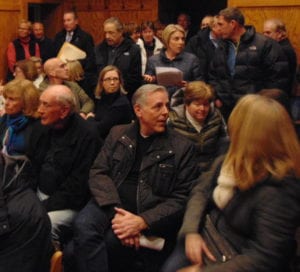By Rita J. Egan
Residents of the Village of Old Field are asking the mayor and trustees, “Can you hear me now?”
The Keeper’s Cottage was filled to capacity Feb. 13 with residents and bordering neighbors expressing concerns over the proposed installation of a cellphone tower at Kaltenborn Commons, a small park located at the intersection of Old Field Road and Quaker Path and surrounded by homes. This is the second time both residents and nonresidents had the opportunity to speak and ask questions about the tower; the first opportunity being at a Jan. 9 public meeting.
A board vote to approve signing a lease with telecommunications tower site developer Elite Towers was not held during the meeting. Mayor Michael Levine said with the upcoming March 20 village elections, two new trustees would be starting in April, and the board agreed the new members should weigh in on the decision.
Former board member John Von Lintig, who lives directly across from the park, presented a petition signed by 100 residents who are against the installation of the cell tower.
“The opposition of the cellphone tower, or pole as you call it, is primarily based on aesthetic reasons, which tie very closely to the impact on real estate immediately in the vicinity of the tower,” Von Lintig said.
“The opposition of the cellphone tower, or pole as you call it, is primarily based on aesthetic reasons, which tie very closely to the impact on real estate immediately in the vicinity of the tower.”
— John Von Lintig
He cited the National Institute for Science, Law & Public Policy’s survey of 1,000 respondents on the impact of cell towers and antennas on real estate properties. He said according to the survey, 94 percent responded that cellphone towers or antennas in a neighborhood would impact their interest in a property and the price they would pay. Von Lintig said 79 percent answering the survey said under no circumstances would they buy a home within a few blocks from a tower or antenna. He said the decline of real estate prices can be anywhere between 2 and 20 percent.
John Damianos said when the land was granted to the village by Hans V. Kaltenborn in 1950 it was meant to be used for recreational purposes. He said the addition of the pole would turn it into a commercial facility.
“When I moved here there were many naturalists and environmentalists,” Damianos said. “A lot of people talked about Flax Pond and other places. They were strongly in favor of preserving natural spaces, open spaces, including this one.”
Jeff Schnee, who recently attended a board of trustees work session to discuss the technologic alternatives to a tower, said a better solution would be using distributed antenna systems. He said there is one in front of Ward Melville High School, and it consists of a 14- to 15-foot microwave antenna and a controlling box.
“[The phone companies] can put that in our neighborhood about every 20 poles in the areas that need it and that’s not intrusive,” Schnee said. “You don’t have to look at it, it doesn’t put out much power.”
Schnee asked if a cellphone tower was necessary with 5G technology, which uses millimeter waves and not microwaves, on the horizon. He said the technology uses receivers and transmitters, which would be every cellphone, Wi-Fi-enabled car and cable box. He said an area such as Old Field, where people buy the latest technology, would be perfect for 5G, and it’s possible it might be available in 2020.
Deputy Mayor Stephen Shybunko said after further research the board found that 5G would not replace 4G entirely as 5G does not penetrate walls and windows and therefore would not work well for voice transmission. Schnee said he believes more research needs to be done and said the debate on the potential of 5G could lead to the formation of a committee of residents who could research the topic before a decision is made about the tower.

Physicist Oleg Gang said a committee would be ideal to also research potential health risks. The scientist handed out a sheet with a list of studies regarding the effects of cell towers on health. Gang showed a meter he used recently when near a comparable tower in Belle Terre. He said the measurements of radio frequency power near the tower — 100 feet to 0.3 mile — indicate RF radiation levels a few times higher than holding a cellphone to one’s ear 24 hours a day, seven days a week.
Board members said they would be open to a committee comprised of Old Field residents. Levine reiterated what was covered at the last board meeting, that the lighthouse is not an option for the Village of Old Field to install a cellphone tower as the U.S. Coast Guard has not given approval. Also, if the village decides not to install a pole, there is still a chance that Stony Brook University will do so on its Sunwood Estate property as the university has filed a request for proposals to install a cellphone tower. If this occurs, the village would not have a say as to where the university installs it on the property and would not generate any revenue from the SBU pole.
Many residents in attendance said they would rather not have better cellphone service, or any service at all, if it negatively affects them and their neighbors in Setauket.
“I would rather pay higher taxes than shaft my neighbors down the road a mile and a half,” one resident said.
After the meeting, Von Lintig said he was optimistic and believed it makes sense to involve new board members in the process.
“As a former village trustee knowing most of the current members well, I believe they will take these concerns under serious consideration and do the right thing to preserve the bucolic nature of our village,” Von Lintig said.





